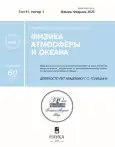Two-parameter model of intense atmospheric vortices
- Authors: Kurgansky M.V.1, Yarynich Y.I.1,2
-
Affiliations:
- Obukhov Institute of Atmospheric Physics RAS
- Lomonosov Moscow State University
- Issue: Vol 61, No 1 (2025)
- Pages: 86-99
- Section: Articles
- URL: https://journals.eco-vector.com/0002-3515/article/view/682938
- DOI: https://doi.org/10.31857/S0002351525010062
- EDN: https://elibrary.ru/HFCFED
- ID: 682938
Cite item
Abstract
A two-parameter family of vortices is studied, in which the air motion near the vortex axis differs from solid-body rotation, and the tangential velocity increases according to a power law. It is shown that such vortices satisfy the angular momentum balance equation augmented with a model of turbulent viscosity, including both the traditional mechanism of eddy viscosity and the mechanism of negative diffusion of angular momentum in the vortex. Emphasis is placed on reconstructing the radial profile of the pressure drop in the vortex in an explicit analytical form. Examples of two-parameter representation of vortices are given, both for discrete, integer parameter values, and for a continuous spectrum of their changes. The results obtained are applied to supercell tornadoes. It is shown that the width of the strip on the surface of the earth swept by the vortex during its movement, and determined from the condition that the wind has hurricane force, systematically decreases when the air motion near the vortex axis deviates from solid-state rotation. Using the downward flux of helicity in a vortex as a measure of tornado intensity, as well as to a certain extent of their "destructive power", confirms these results. The question of the best approximation, within the framework of a generalized two-parameter family of vortices, of the radial profile of the tangential velocity in the well-known Sullivan vortex is discussed.
Full Text
About the authors
M. V. Kurgansky
Obukhov Institute of Atmospheric Physics RAS
Email: kurgansk@ifaran.ru
Russian Federation, Pyzhevsky per., 3, bld. 1, Moscow, 119017
Yu. I. Yarynich
Obukhov Institute of Atmospheric Physics RAS; Lomonosov Moscow State University
Author for correspondence.
Email: julia.yarinich@yandex.ru
Lomonosov Moscow State University, Research Computing Center; Lomonosov Moscow State University, Faculty of Geography
Russian Federation, Pyzhevsky per., 3, bld. 1, Moscow, 119017; Leninskie Gory, 1, bld. 4, Moscow, 199991References
- Вараксин А.Ю. Воздушные торнадоподобные вихри: математическое моделирование // ТВТ. 2017. Т. 55. № 2. С. 291–316.
- Градштейн И.С., Рыжик И.М. Таблицы интегралов, рядов и произведений (7-е изд.). СПб: БХВ-Петербург, 2011. 1232 с.
- Курганский М.В. Вертикальный поток спиральности в атмосферных вихрях как мера их интенсивности // Изв. РАН. Физика атмосферы и океана. 2008. Т. 44. № 1. С. 67–74.
- Курганский М.В. Спиральность в атмосферных динамических процессах // Изв. РАН. Физика атмосферы и океана. 2017. Т. 53. № 2. С. 147–163.
- Курганский М.В. Симметричная устойчивость вертикальных бароклинных вихрей с теплым ядром // Изв. РАН. Физика атмосферы и океана. 2023. Т. 59. № 3. C. 251–264.
- Онищенко О.Г., Похотелов О.А., Астафьева Н.М., Хортон В., Федун В.Н. Структура и динамика концентрированных мезомасштабных вихрей в атмосферах планет // УФН. 2020. Т. 190. №7. С. 732–748.
- Bretherton F.P., Turner J.S. On the mixing of angular momentum in a stirred rotating fluid // J. Fluid Mech. 1968. V. 32. P. 449–464.
- Burgers J.M. A mathematical model illustrating the theory of turbulence, Advances in Applied Mechanics (Academic Press, New York). 1948. V. 1. P. 171–199.
- Chkhetiani O., Kurgansky M. Kinetic helicity in the Earth’s atmosphere. In: Helicities in Geophysics, Astrophysics, and Beyond, Geophysical Monograph 283, First Edition. Edited by Kirill Kuzanyan, Nobumitsu Yokoi, Manolis K. Georgoulis, and Rodion Stepanov. 2024 American Geophysical Union. Published 2024 by John Wiley & Sons, Inc. doi: 10.1002/9781119841715.ch10. Also: arXiv:2303.06363v1 [physics.flu-dyn] https://doi.org/10.48550/arXiv.2303.06363
- Coleman T.F., Li Y. An interior, trust region approach for nonlinear minimization subject to bounds // SIAM J. Optim. 1996. V. 6. P. 418–445.
- Fiedler B.H. Conditions for laminar flow in geophysical vortices // J. Atmos. Sci. 1989. V. 46. P. 252–259.
- Karstens C.D., Samaras T.M., Lee B.D., Gallus Jr. W.A., Finley C.A. Near-ground pressure and wind measurements in tornadoes // Mon. Wea. Rev. 2010. V. 138. P. 2570–2588.
- Kurgansky M.V., Lorenz R.D., Renno N.O., Takemi T., Gu Z., Wei W. Dust devil steady-state structure from a fluid dynamics perspective // Space Sci. Rev. 2016. V. 203(1–4). P. 209–244.
- Lorenz R.D. Vortex encounter rates with fixed barometer stations: Comparison with visual dust devil counts and large-eddy simulations // J. Atmos. Sci. 2014. V. 71. P. 4461–4472.
- McEwan A.D. A laboratory demonstration of angular momentum mixing // Geophys. Fluid Dyn. 1973. V. 5. P. 283–311.
- McEwan A.D. Angular momentum diffusion and the initiation of cyclones // Nature. 1976. V. 260. P. 126–128.
- Rott N. On the viscous core of a line vortex // J. Appl. Math. Phys. (ZAMP). 1958. V. 9b. P. 543–553.
- Samaras T.M., Lee J.J. Pressure measurements within a large tornado // Preprints, Eighth Symp. on Integrated Observing and Assimilation Systems for Atmosphere, Oceans and Land Surface, Seattle, WA, Amer. Meteor. Soc. 2004. Paper 4.9. https://ams.confex.com/ams/84Annual/techprogram/paper_74267.htm
- Scully M.P. Computation of helicopter rotor wake geometry and its influence on rotor harmonic airloads. MIT Rep. ASRL TR 178-1. 1975. 469 pp.
- Stull R.B. Meteorology for Scientists and Engineers. 3rd ed. Univ. of British Columbia, 2011. 938 pp.
- Sullivan R.D. A two-cell vortex solution of the Navier–Stokes equations // J. Aerosp. Sci. 1959. V. 46. P. 767–768.
- Vatistas G.H., Kozel V., Mih W.C. A simpler model for concentrated vortices // Exp. Fluids. 1991. V. 11. P. 73–76.
- Wood V.T., Brown R.A. Simulated tornadic vortex signatures of tornado-like vortices having one- and two-celled structures // J. Appl. Meteor. Climatol. 2011. V. 50. P. 2338–2342.
- Wood V.T., White L.W. A new parametric model of vortex tangential–wind profiles: Development, testing and verification // J. Atmos. Sci. 2011. V. 68. P. 990–1006.
- Wurman J., Kosiba K., White T., Robinson P. Supercell tornadoes are much stronger and wider than damage-based ratings indicate // Proc. Natl. Acad. Sci. U. S. A. 2021. V. 118(14). e2021535118
Supplementary files
















